
Thank you for visiting HOJO website. If you have any enquiry, please feel free to get in touch with us at
▼ Akira Hojo
▼ Hojo Newsletter




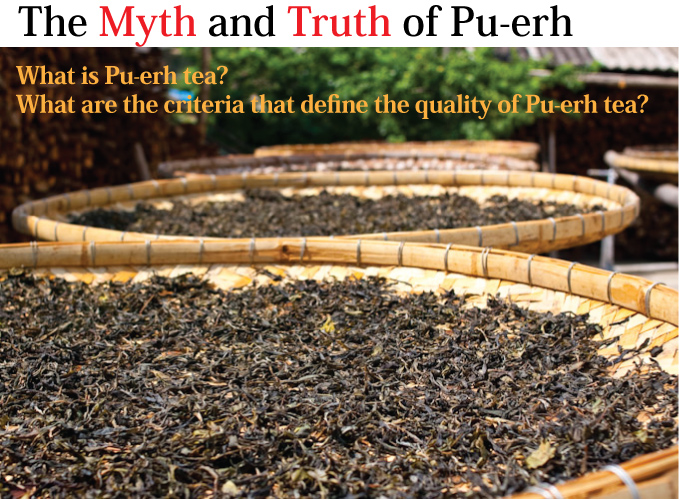
What is Pu-erh tea?
What are the criteria that define the quality of Pu-erh tea?
How do we choose the right quality?
I have visited Yunnan and stayed there for a few weeks. I would like to share my experience with you, and to answer the questions above.
Pu-erh tea are originally made in a place called Xishuang Banna (西双版納), located at the South end of Yunnan province. Historically, Pu-erh tea was produced for own consumption by the minority races, and sometimes it was export to Tibet, Mongolia or South East Asia. Pu-erh tea was an important commodity in export. The Chinese merchants hired the local labor as the transporter and Pu-erh tea was traded for horses or other products in return. The road used for this trade was called “The Ancient Tea Route” (茶馬古道). It is sometimes considered as the second Silk Road as it was a very important commercial route for them.
Xishuang Banna is situated on the Southern end of Yunnan. This name “Xishuang Banna” is originated from Thai language. This state is facing the border of Myanmar, Vietnam and Laos. The ancient route of Tea and Horse begins from a town called Yiwu (易武), and it connects all the way up to the North. Tea was once stocked and gathered at a town called Pu-erh (普洱); it was the hub for Pu-erh trading and logistics. This is why the minority’s tea was named as Pu-erh. In the history, Pu-erh tea was rather considered as an ethnical tea specially made and drunk by minority races.
 |
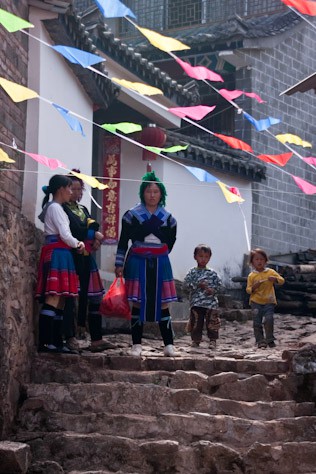 |
|
| Yiwu Village: The origin of Ancient Tea Route | Minority Races at Ancient Tea Route |
However drinking Pu-erh tea became a fashionable lifestyle in past decade. Tea collectors from Guangzhou, Hong Kong and Taiwan triggered the boom of Pu-erh. In 2006-2007, as Pu-erh’s market price skyrocketed to a new peak, an overwhelming number of poor qualities were produced and ran over the market. In 2008, the Pu-erh boom suddenly cooled down as quick as it started and now it is over in China.
From the customer’s point of view, now is an ideal condition to obtain good Pu-erh since price is lower and the poor quality ones already been rejected by the market. Pu-erh is the only tea that gives us a chance to enjoy the taste of leaves produced from ancient tea trees. No doubt good Pu-erh tea is worthwhile to drink. Since now the timing is right, HOJO focuses on high-end quality and decided to introduce Pu-erh tea to our customers.
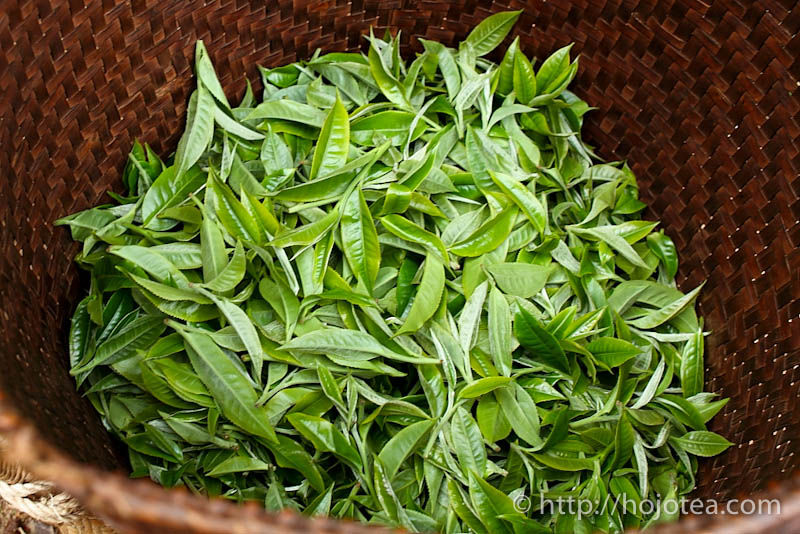 |
 |
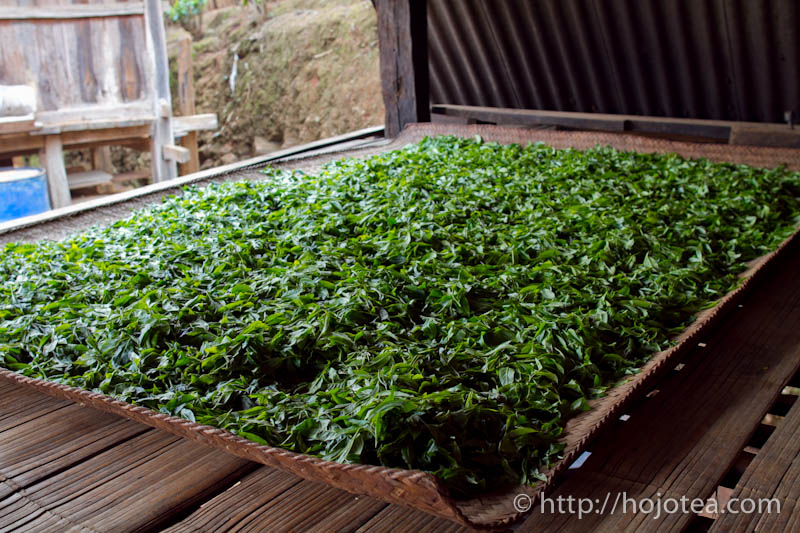 |
 |
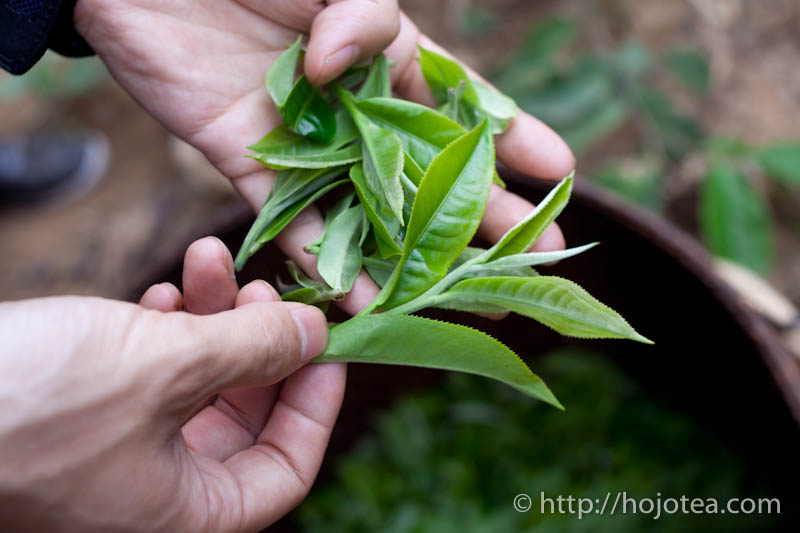 |
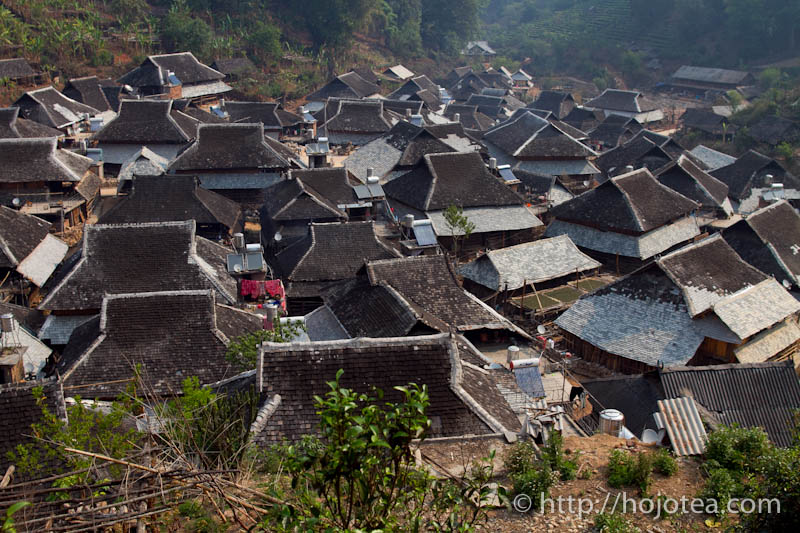 |
 |
 |
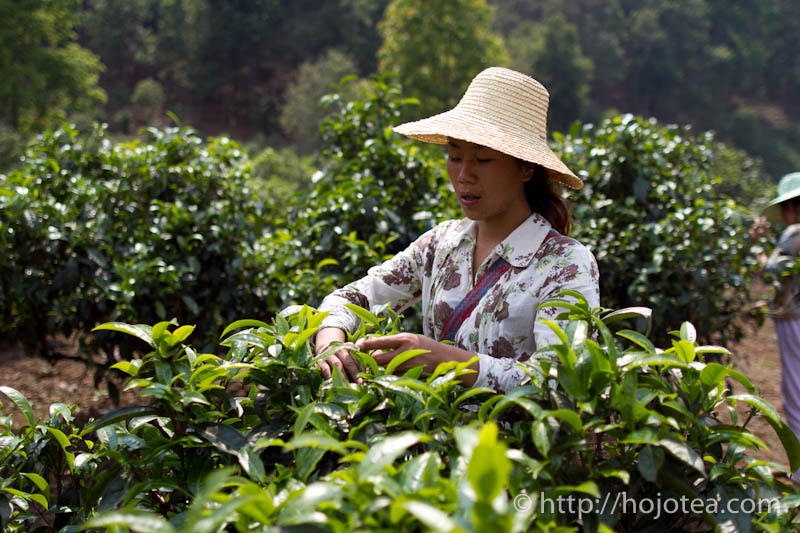 |
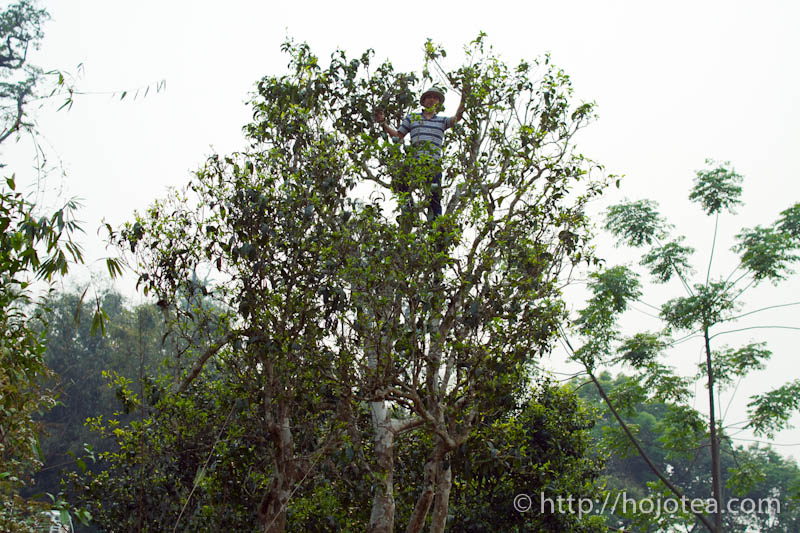 |
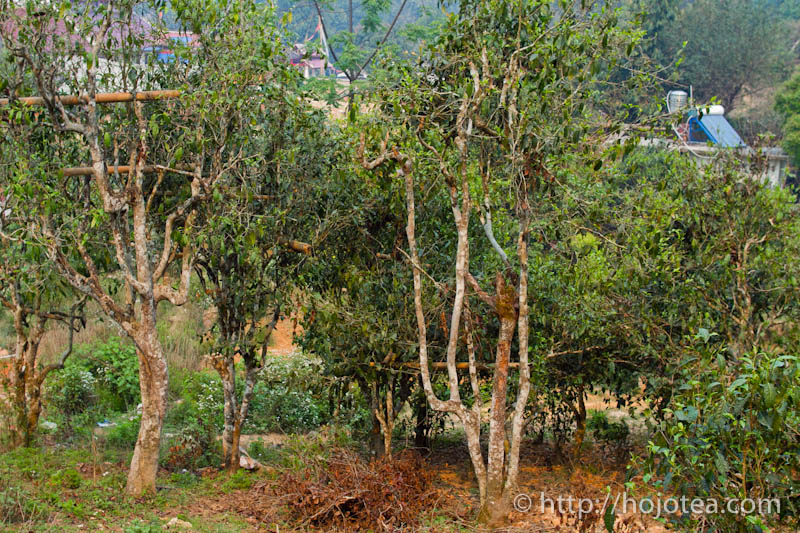 |
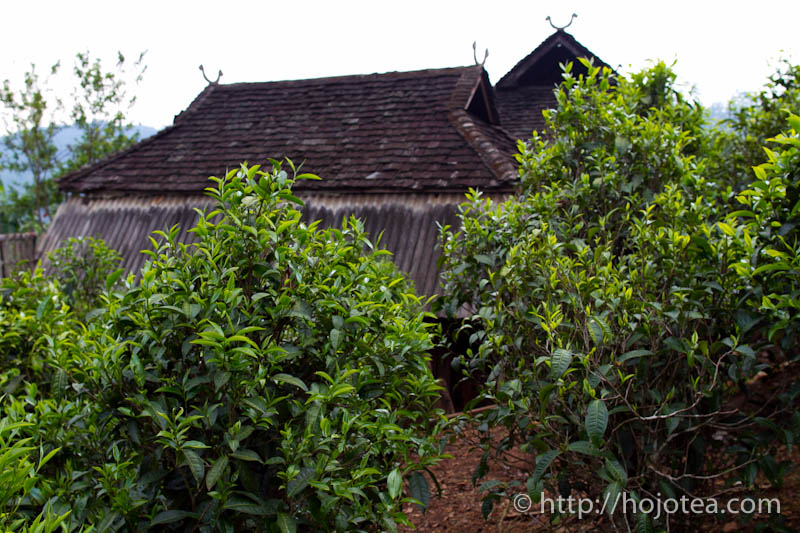 |
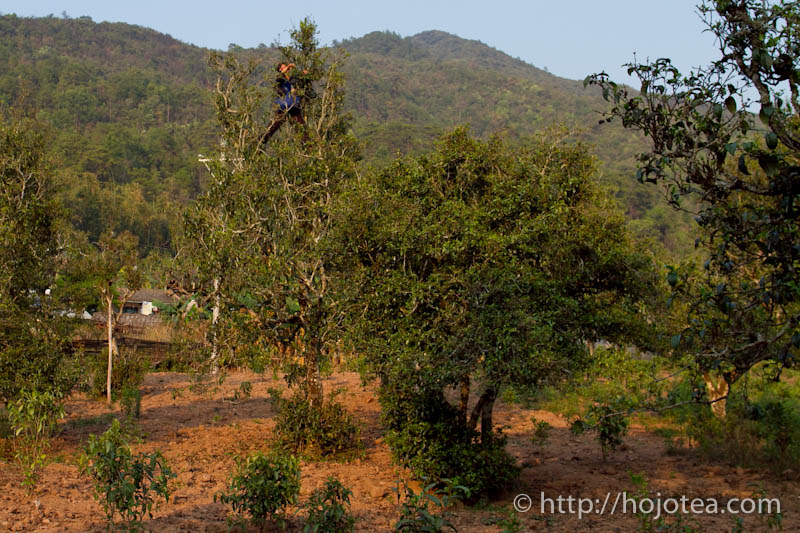 |
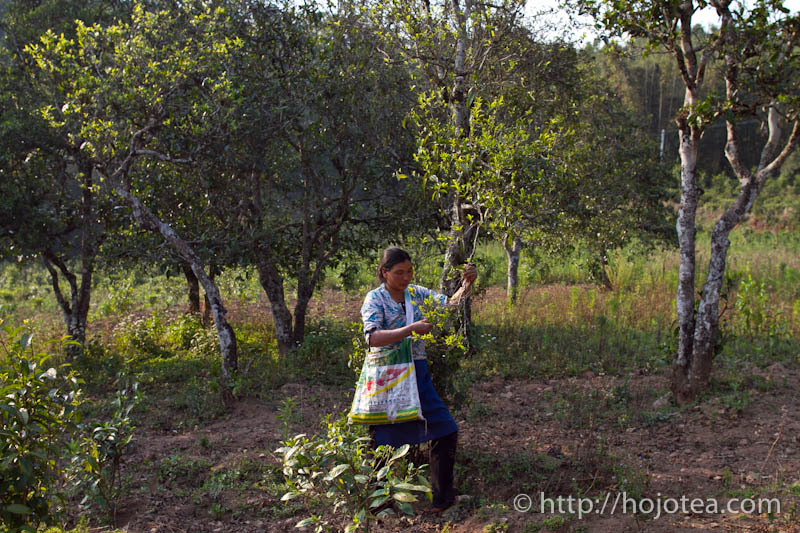 |
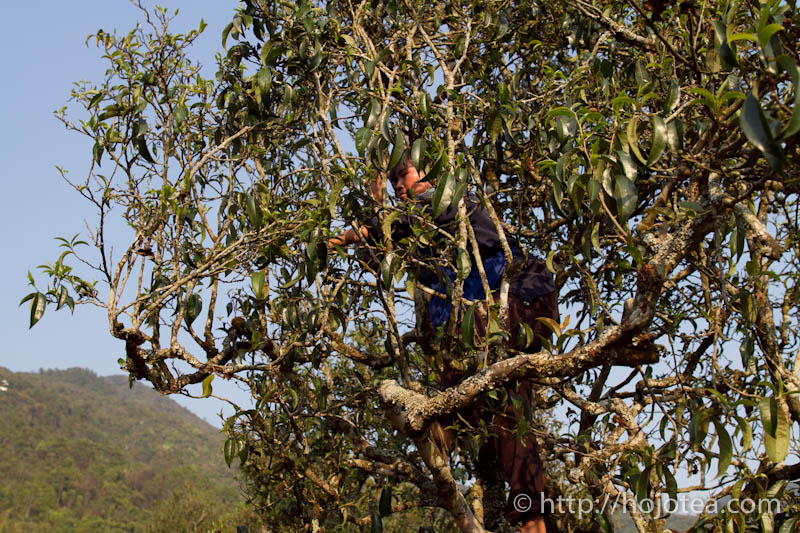 |
 |
 |
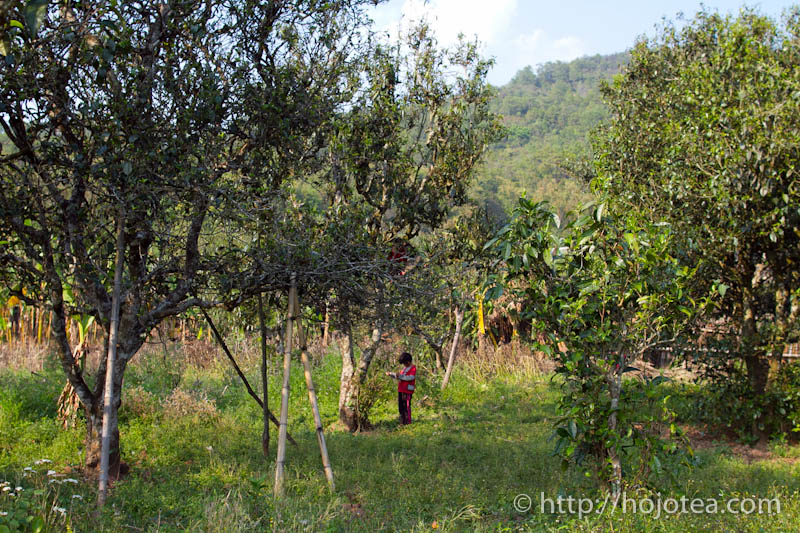 |
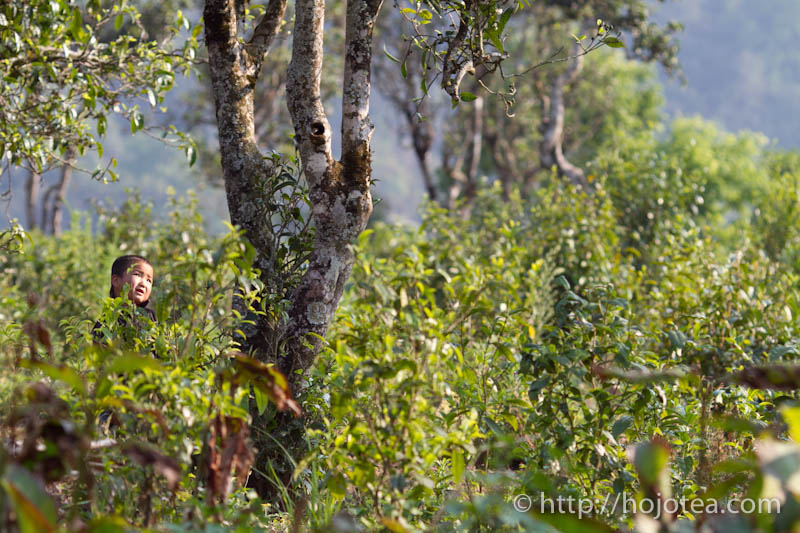 |
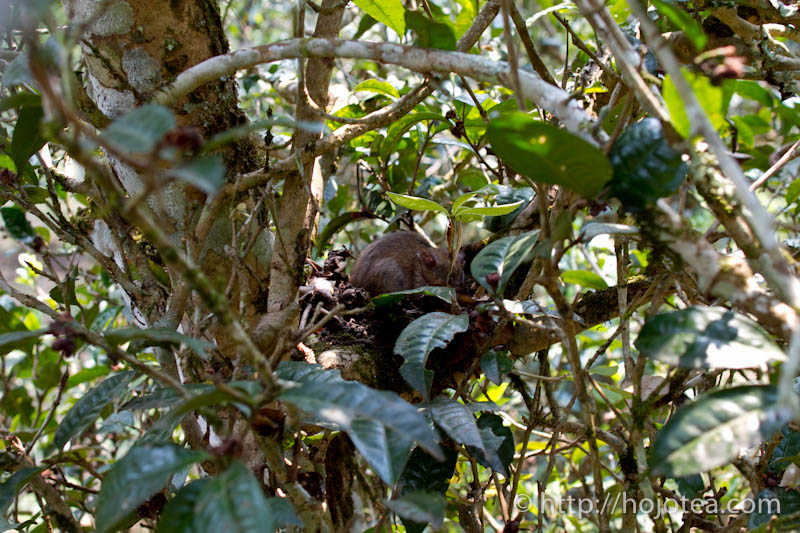 |
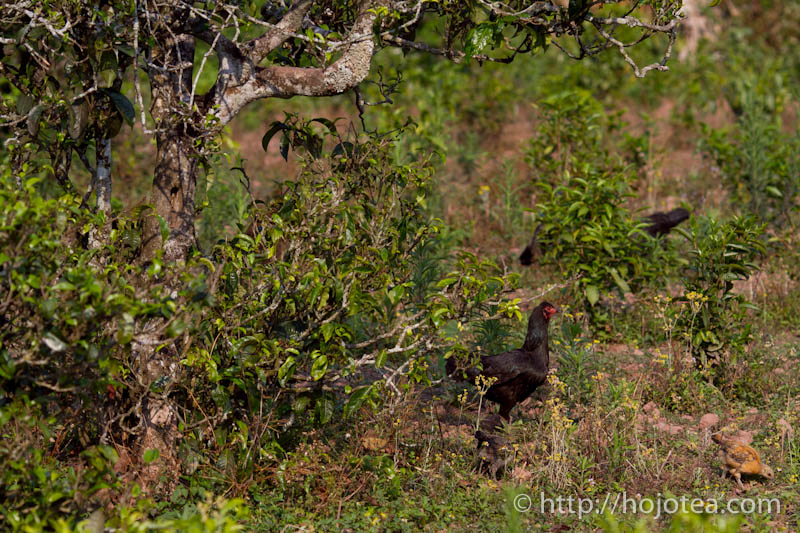 |
 |
 |
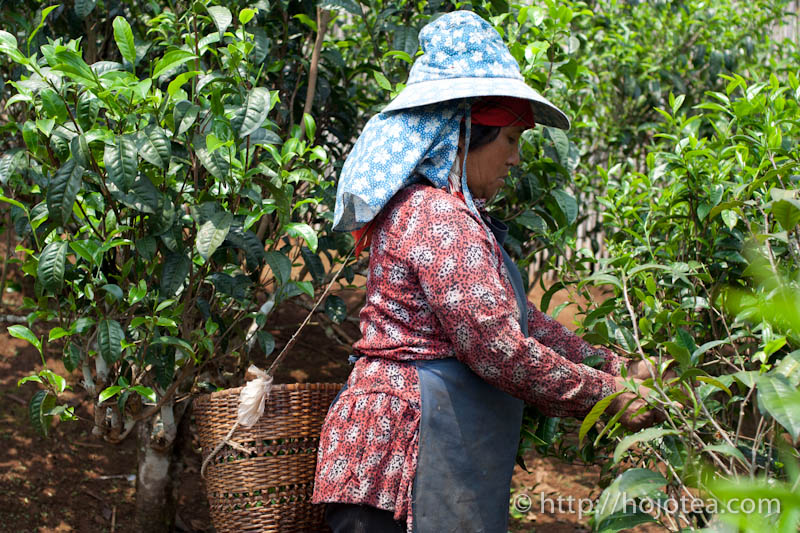 |
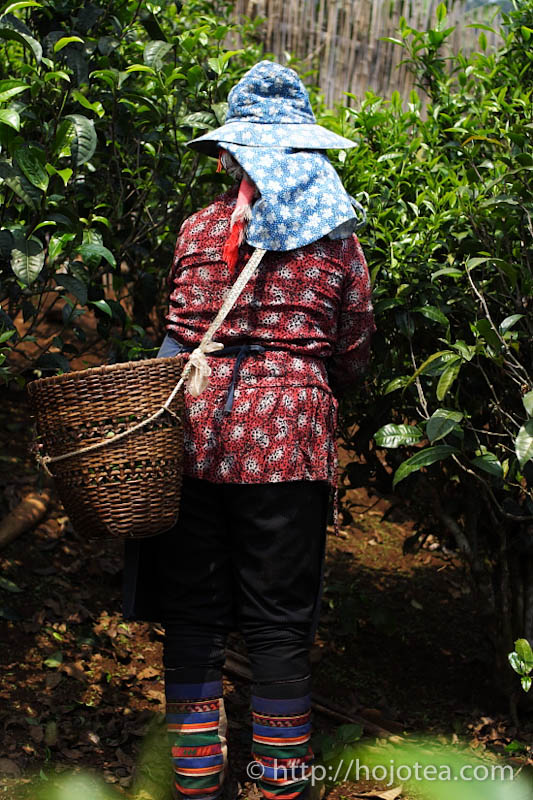 |
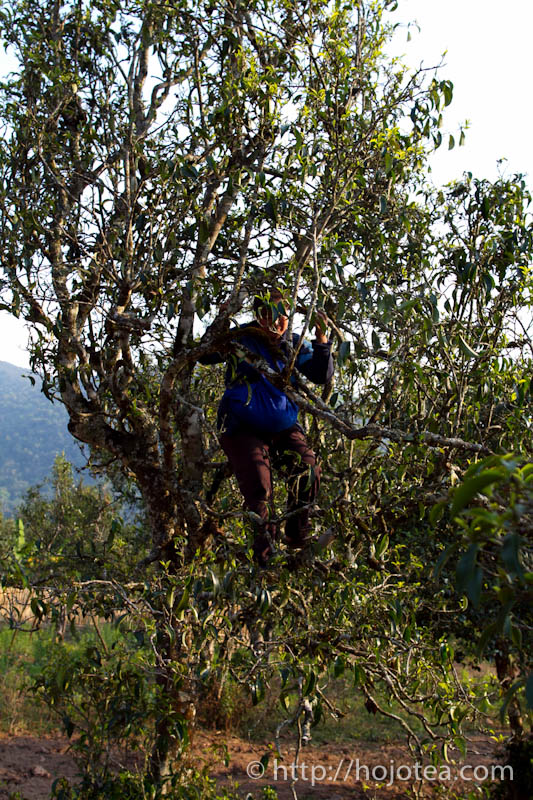 |
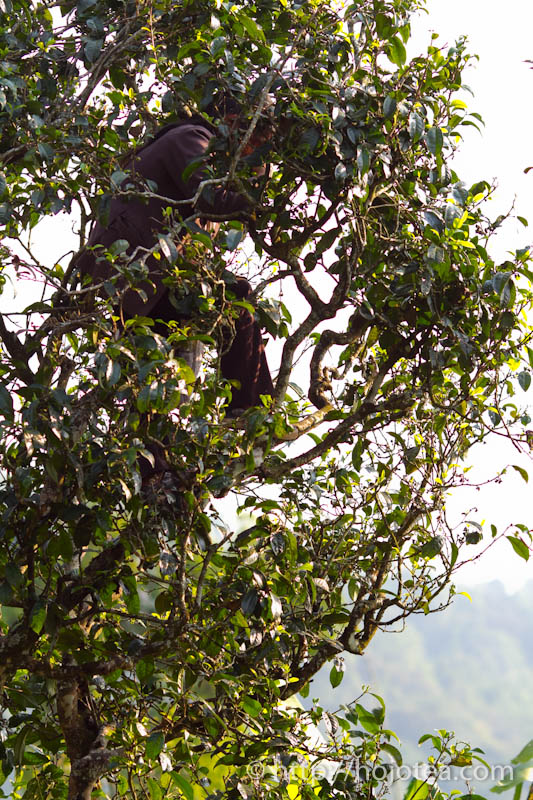 |
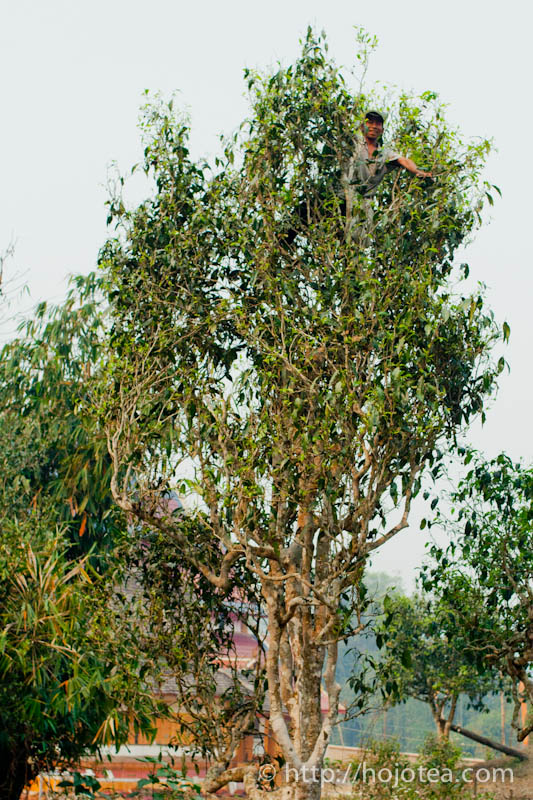 |
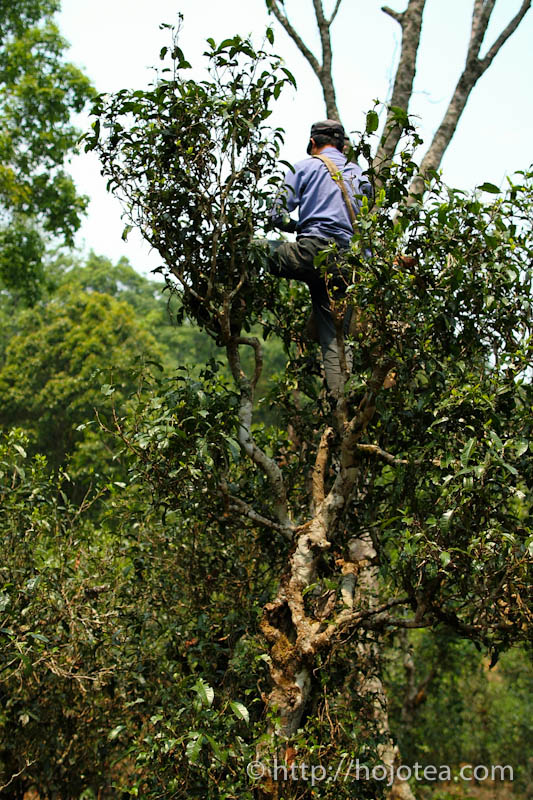 |
 |
The Pu-erh tea consists of 2 completely different categories. One is called “Raw Pu-erh” and another is “Ripe Pu-erh”.
Raw Pu-erh has a very long history and it was the tea traded through The Ancient Tea Route. Raw Pu-erh is also the tea that many tea collectors are enthusiastically searching for.
As for ripe Pu-erh, it was developed recently in 1973-4. Thanks to the innovation of express post-fermentation method, we do not have to wait for 10-20 years to get the tea matured. Less than 1 year of fermentation allow us to enjoy similar flavor and taste just like an aged vintage raw Pu-erh.
Usually a beginner tea drinker appreciates ripe Pu-erh, while the experts and collectors appreciate raw Pu-erh. However, raw Pu-erh and ripe Pu-erh tea is completely two different types of tea.
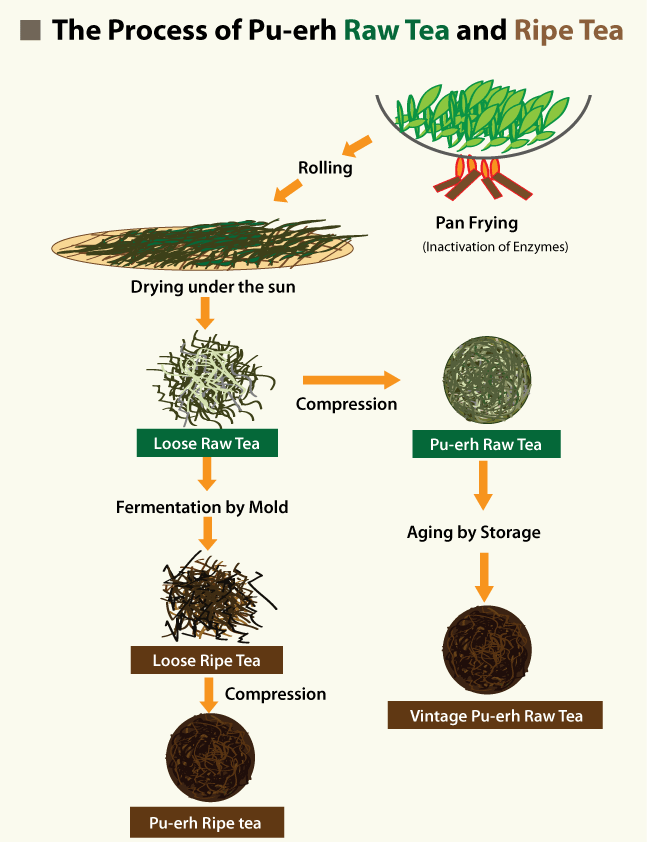
In the market, some Pu-erh teas contain a lot of silver tips in its cake. Most of them were made with the addition of white tea for cosmetic purpose. One of the factories I visited in Wu Liang Shan area is specialized in producing silver needle for blending purpose. Silver needle is made of tea buds that are still covered with white silver fur. Usually these silver needles were sold to Kunming for further blending prior to compressing process. We should not judge the quality of Pu-erh based on its appearance but instead on its taste and flavor.
The plucked tea leaf is fried in a pan in order to inactivate enzymes. In fact, pan-frying process does not completely inactivate enzymes but some enzymes still remain alive, unlike Japanese tea which enzyme is completely inactivated due to the intensive heat treatment with saturated steam. Chinese green tea should be the same way since it is also pan-fried. But Chinese green tea is subsequently dried with hot air that eventually inactivates the remaining enzymes. As for Pu-erh, tea leaf is not dried with hot air, but dried under the sun.
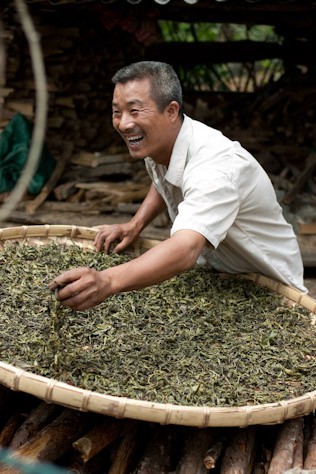 |
 |
|
| Pu-erh tea leaves are collected on a bamboo plate right after pan-frying | Regardless of the grade, "all Pu-erh" are dried under the sun |
|
 |
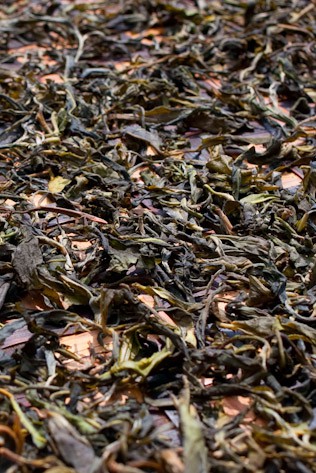 |
|
Semi-fermentation of tea makes leaf very colorful |
Sunshine drying does not increase the temperature of leaf, and therefore the remaining enzyme stay alive. The leaf is spontaneously fermented during the sunshine drying process and produce identical flavor of Pu-erh. The reason why we can enjoy the aging of Pu-erh during storage is that there is continuous oxidation taken place during the aging of Pu-erh. This is the major difference between Pu-erh and green tea. Due to the subsequent oxidation, the character of raw Pu-erh is rather similar to semi-fermented tea or yellow tea.
The tea leaf of freshly-made raw Pu-erh is still green in color. The longer it is kept, the browner in color it became. At first, it changes from yellow to amber color in the first 5-years time. Then it gradually turns into brown color in the following 10 years. The taste of freshly produced raw Pu-erh is similar to the taste of green tea. With moderate oxidation along with storage, its character will change similar to white tea. With further oxidation, the character of tea becomes a little closer to oolong tea, and finally it becomes like Pu-erh ripe tea or similar to black tea. The joy of drinking Pu-erh is to enjoy different taste and flavor according to the year of storage. The flavor also differs depending on the storage method too.
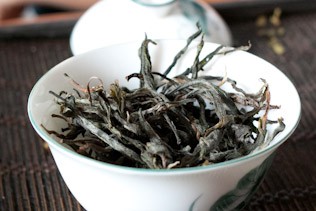 |
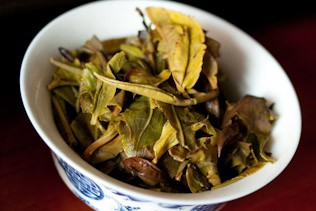 |
|
| Tea leaf of raw pu-erh before compression | The brewed tea leaf of fresh pu-erh raw tea: It appears yellowish-green in color just like oolong tea. |
Ripe Pu-erh has a much shorter history compared to raw Pu-erh. Ripe Pu-erh was invented in 1973-1974 by Kun-ming Tea Factory (昆明茶厂). It was developed by referring to the process of ancient dark tea such as Fuzhuan Cha that is made with mold fermentation. During fermentation, mold produces organic acid and pH of tea will be reduced. Due to the mold fermentation, tea is completely fermented in a much shorter period of time. The color of tea changes to dark brown and it gives a mellow taste with thick body. Good quality ripe Pu-erh gives flavor like dried Chinese dates. In oversea market, ripe Pu-erh is more popular.
In Yunnan, the cost of ripe Pu-erh is generally cheaper than raw pu-erh. Majority of ripe Pu-erh is made of tea leaf that is planted in tea garden at lower altitude, while high mountain tea is generally used for making raw Pu-erh.
Not only Pu-erh tea, but also for all kinds of tea, the depth of taste and flavor defines the Quality. The depth of taste is also called as "after taste" in English expression. In Chinese it is called Hou Yun. “Hou” means throat and “Yun” means lasting lingering charm. Hou Yun means the taste that is felt in our throat and lingered. In English, I cannot find an appropriate term to describe this feeling. Perhaps the closest term to describe this feeling is “aftertaste”, “depth of taste” or “long finishing”.
Hou Yun gives depth to the taste. In other word, it builds up the taste in three-dimensional way. The intensity of Hou Yun is made up with minerals. On the other hand, flavor defines the character or individuality of tea. We cannot compare the superiority of different flavors. Flavor is like the color of a photograph. A different brand of camera or lens gives different color. However color does not define the quality of lens or camera. We usually appreciate depth and blur effect that creates a three dimensional visual impact to the photograph. Similarly, Hou Yun means the depth of taste and the feeling that continuously lingers in our throat. This is what defines the true quality of tea.
Hou Yun is an essential factor to define not only the quality of tea, but also the quality of food, including wine, vegetables, fruits, beer, sake and juices.
Let’s compare two cup of fruit juices, one taste delicious and the other not so delicious.
What do you think the difference is?
Is it the sweetness? Does low quality fruit juice get better if sugar is added?
Or is it because of flavor? Does low quality fruit juice get better if flavor is added?
As the matter of fact, both sweetness and flavor is not the essential factor to define the quality of juice that gives us the satisfaction. For food and beverage, good quality product gives depth in taste. It is the Hou Yun that makes the taste and flavor of food 3 dimensional.
The Hon Yun defines the quality of Pu-erh tea, thus the price of tea is in proportion to the intensity of Hou Yun. Under the circumstances, one must know how to detect Hou Yun. Unfortunately very few people know how to appreciate Hou Yun. If one does not know how to appreciate Hou Yun, there is no choice but to depend on the “brand”. This is the reason why many people look for the tea that is produced from famous factories. In fact, big factories can hardly produces high quality Pu-erh since they need to blend teas in order to get consistent supply for committed quantity. The intensity of Hou Yun is defined by the quality of material. The processing of tea does not affect to the Hou Yun. If tea leaf of good quality is harvested, Hou Yun must be pretty good no matter how terrible the tea is processed. On the other hand, the intensity of Hou Yun will never be improved no matter how good the tea was processed if the raw material is not of good quality.
There is only one exceptional case that the Hou Yun of ripe Pu-erh will change in relative to certain kind of mold fermentation. For this, I will explain later.
Higher altitude is essential not only for Pu-erh, but also for all kinds of tea. With high elevation, tea trees receive stronger sunshine in daytime, yet the temperature at night is very low. Under such extreme weather condition, tea leaves are able to produce more substance and preserve it because of less consumption at night. Eventually tea gives a very rich flavor and strong in Hou Yun.
 |
 |
|
| In West Yunnan: Most places consist of high mountain and occupied by minority races | Wu Liang Mountain Range: It is the largest mountain range situated from South West Yunnan to West Yunnan. The ideal weather condition produces a number of quality pu-erh teas. |
Geographically, the South Yunnan is facing Vietnam and Laos. The weather there is as tropical as South East Asia. On the other hand, the weather in South West to West Yunnan is much colder on account of the higher latitude. In general, the gap of temperature between daytime and nighttime is even wider at higher latitudes. However if the latitude is too high, it is too cold at night and not suitable for growing tea.
In Yunnan, both the altitude and latitude of Wu Liang Shan (无量山) is considerably high. The temperature during the day time could go up to nearly 30 degree C, while temperature at night goes down to even 3 degree C. This is the ideal climate that makes tea taste very strong in Hou Yun and rich in flavor.
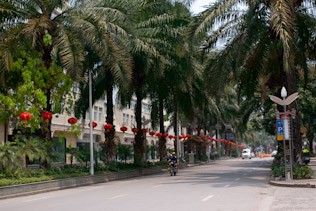 |
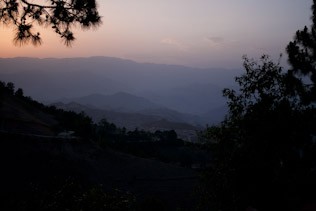 |
|
ishuang Banna is situated in the South Yunnan. This state is facing Laos and Vietnam. If you visit there, you can hardly think it is China. The culture, food, language and weather is just like South East Asia. |
The weather and ecology of South West Wu Liang Shan is completely different from the South Yunnan. |
Some places that are situated in South Yunnan such as Bu Lang Shan (布朗山) or Lao Ban Zhang (老班章) exceptionally produce good quality tea. These 2 areas are not located at higher latitude. The lack of latitude has been made up with the age of tea tree and some other factors. In Yunnan, the age of tree is considered as a very important factor to get tea with good Hon Yun. The root grows longer when the age of tree gets older. With longer root, the surface area of roots increased and hence the ability of tree to absorb mineral from the soil is increased.
In Yunnan, the tea tree is classified into 4 different categories as follows.
Literally it is the tea made from the tea garden. In Yunnan the history of garden tea is short. In general, majority of ripe Pu-erh is made from garden tea. Comparatively, garden tea gives a weaker Hon Yun in general, unless the garden is situated at very High Mountain that is more than 2200m.
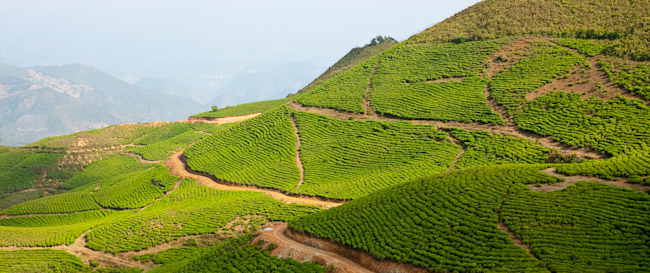
Tea tree grows in the mountain and the age of tree is at around 100-300 years old. The tea tree is planted on the slope of the mountain in between wild-grown native trees. The Hou Yun of tea from this category is much stronger than the garden tea in general. The tea gives more Hou Yun than garden tea not only because of longer root, but also thanks to the minerals provided by the fallen leaves from native tree and grass from the native plants growing in surrounding environment. It gives intermediate level of Hou Yun if the altitude of mountain is less than 2000m. For those that are situated more than 2000m, tea gives a very strong Hou Yun.
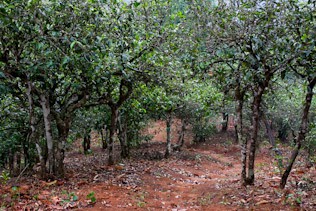 |
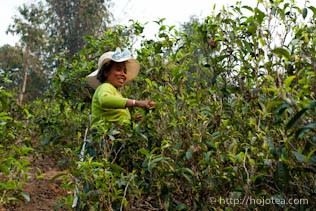 |
|
| The age of tea trees is about 100 to 300 years old | Tea tree is naturally grown and there are many other trees growing aside of tea tree. |
It is referring to the tea that aged 300 years and above, and growing on the slope of mountain. Tea in this category is considered as the best raw material in Yunnan. In fact, it gives extremely strong Hou Yun. The freshly plucked leaf from those old trees itself gives strong Hou Yun. However the price of these teas tends to be very high.
Due to the limited supply of leaf from old tree, the availability is very limited. In any case, old tea tree does not guarantee the best quality. If tea is made from the middle age tree that is grown at very high mountain (>2200m), the quality could be as good as the tea made from those old trees, moreover the price is lower. Both middle age tree and old tree is grown under the organic environment. As they grow in the mountain, the tea trees are treated just like native trees in the mountain.
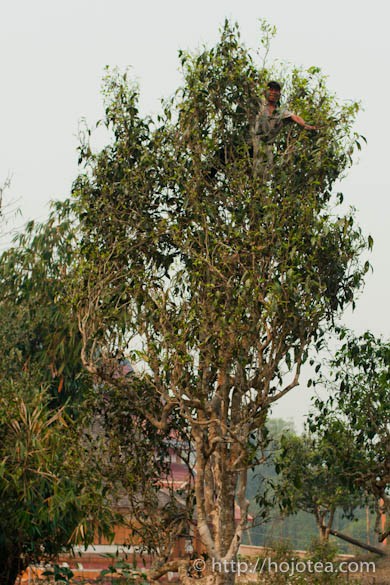 |
 |
|
Tea tree at about 800 years old |
Age a few hundred years old |
|
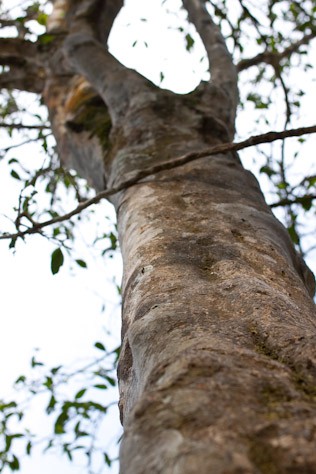 |
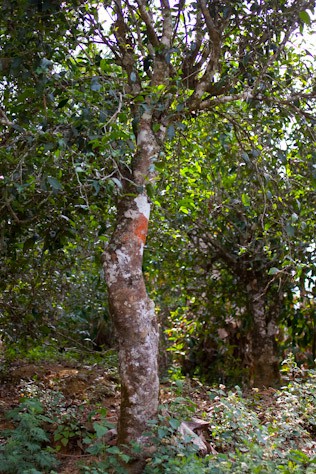 |
|
|
The old tea tree already becomes part of other native trees in the mountain |
The last category is called “wild tree”. This is referring to the native tea trees grown deep inside the jungle. I guess you must have seen the tea that labeled as “wild tea” (野生茶). However many of those acclaimed “wild tea” are not the wild tree but ancient tree. People often call it “wild” for the tea planted in the mountain. In Yunnan, this terminology seems to be often applied in the tea market in order to simply attract the customers.
There are genuine wild trees available in Yunnan. They are often seen relatively higher altitude, more than 2000m inside the mountain of South West Yunnan. The wild tea consists of various types in terms of leaf size, shape and not to mention about the taste and flavor. These varieties are made of natural hybrid. Generally wild tea gives very strong after taste and some extent of bitterness.
The typical identity of wild tea is not the size of leaf, but the length of twig. Since tree grows under the shade in the forest, tree try to grow higher and higher in order to get more sunshine. As the result, the twig of wild tea becomes very long.
We also found wild pepper tree while we were looking for the wild tea. It grew at the altitude around 2000m.
Please click any photo below to enlarge it. These photo was taken when I visited Wu Liang Shan where wild tea tree exists at around 2000-2300m deep inside the forest.
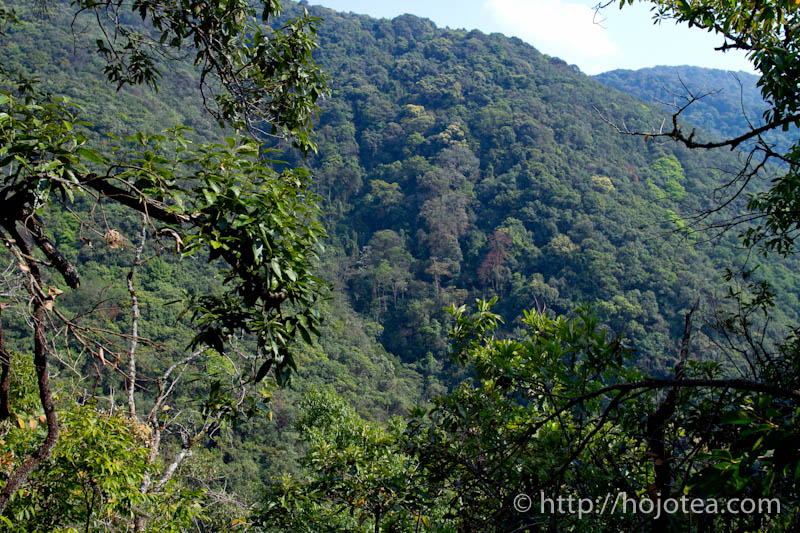 |
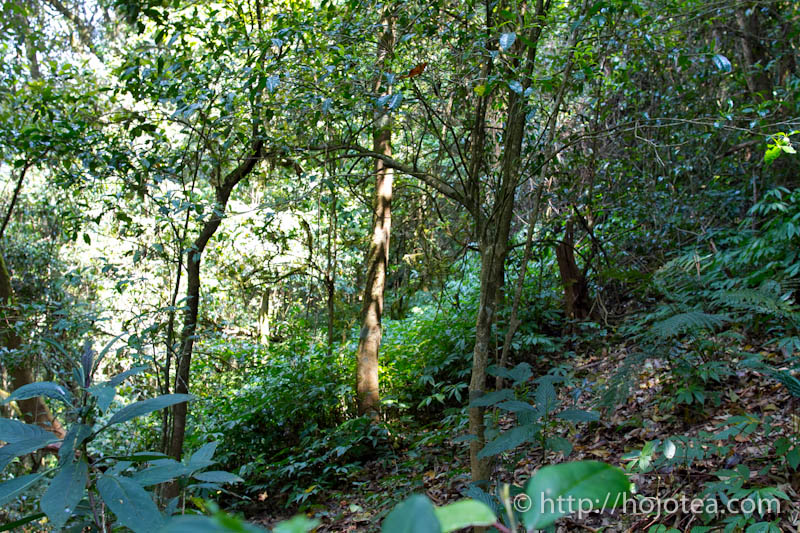 |
 |
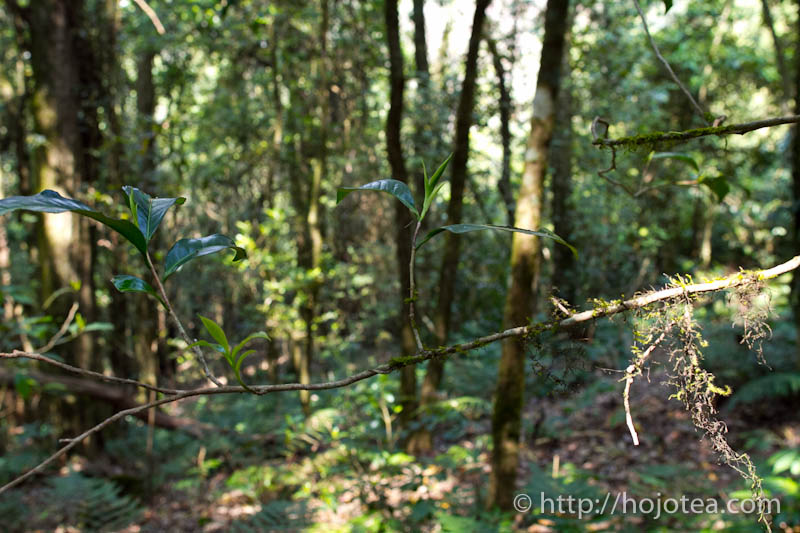 |
 |
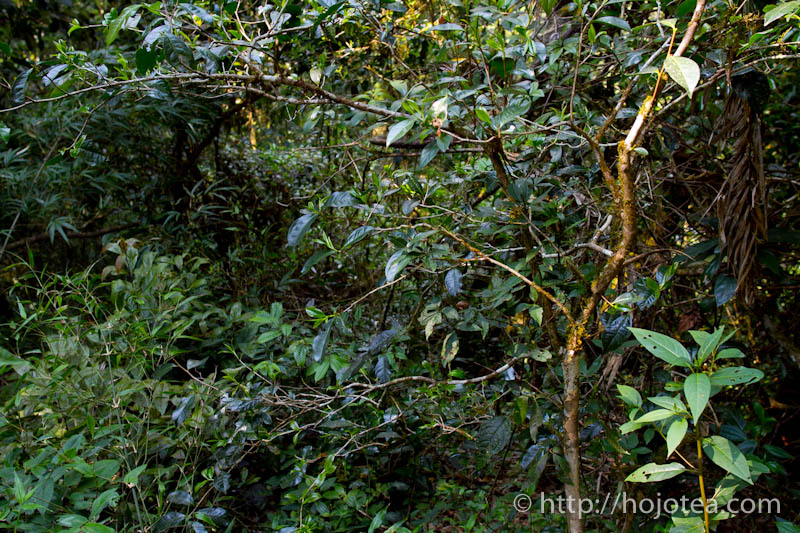 |
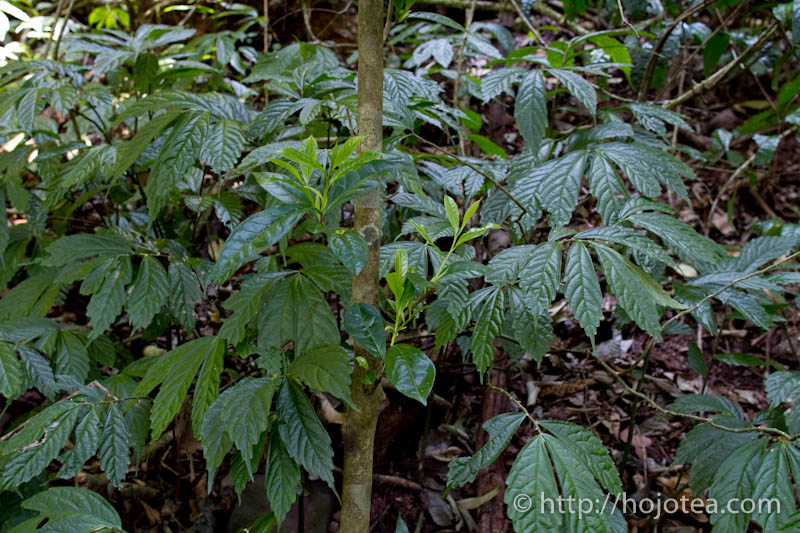 |
 |
 |
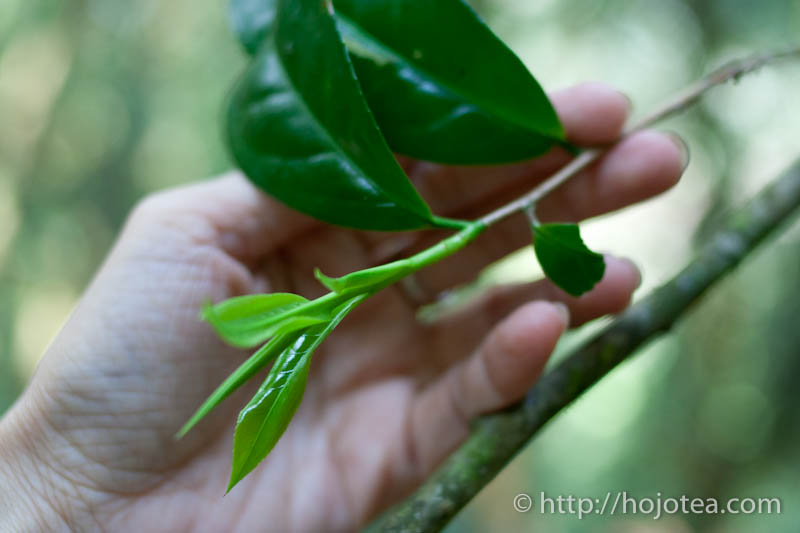 |
 |
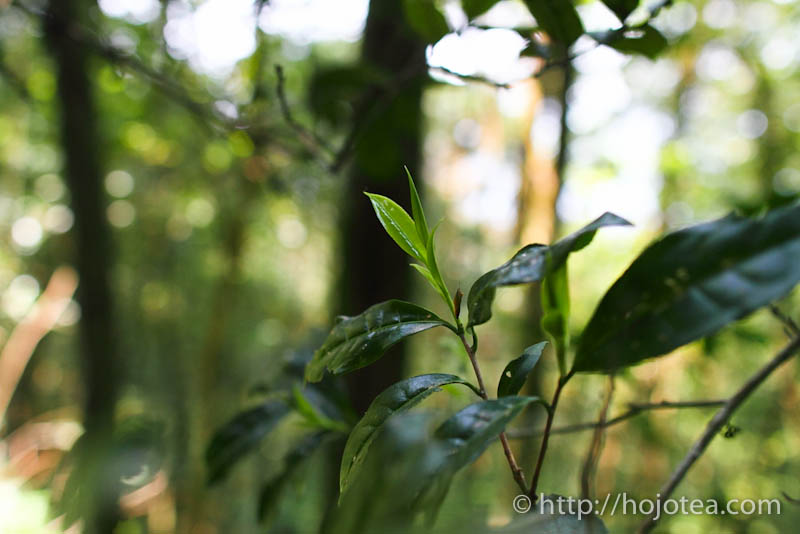 |
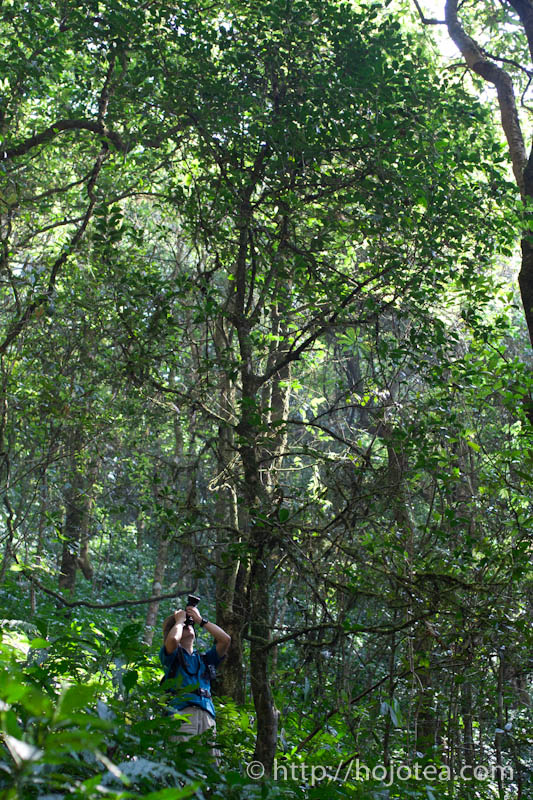 |
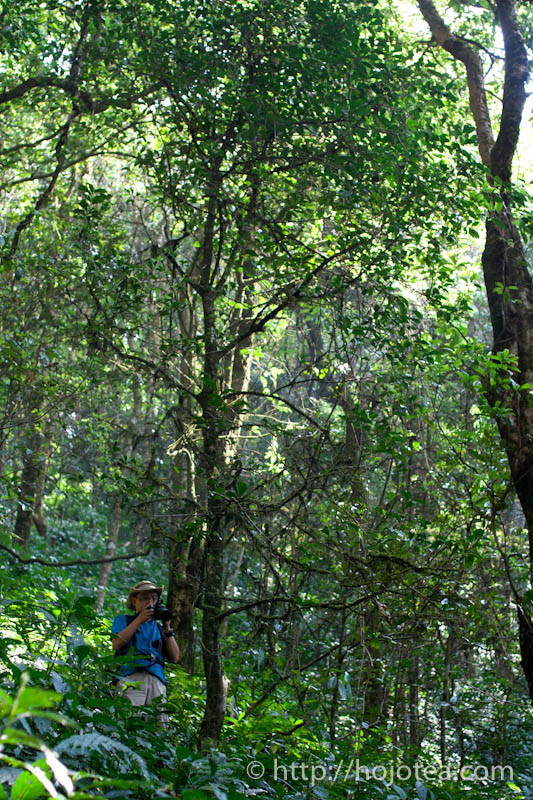 |
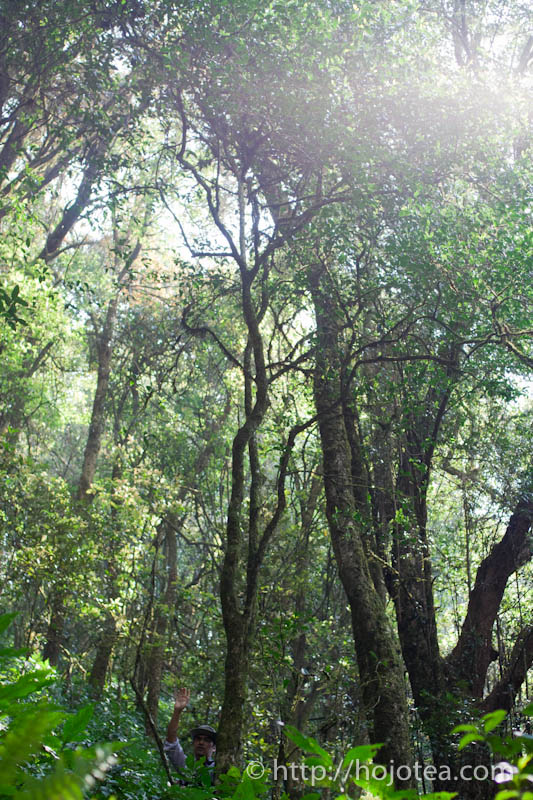 |
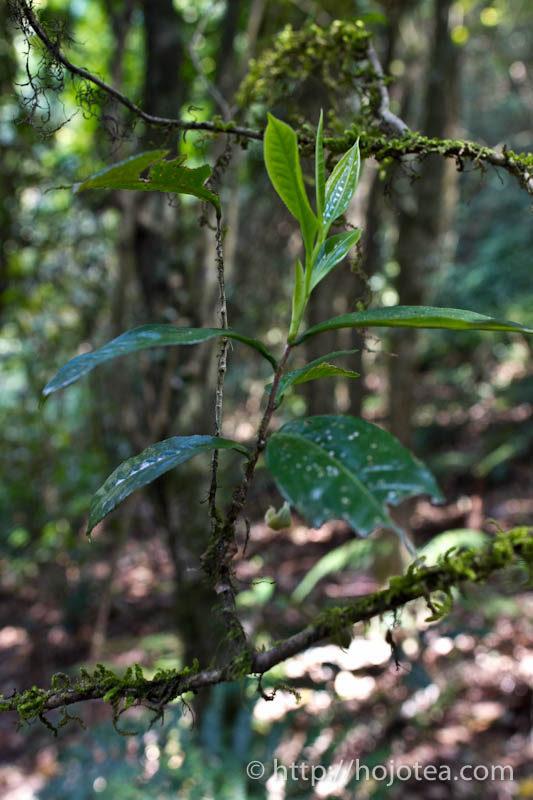 |
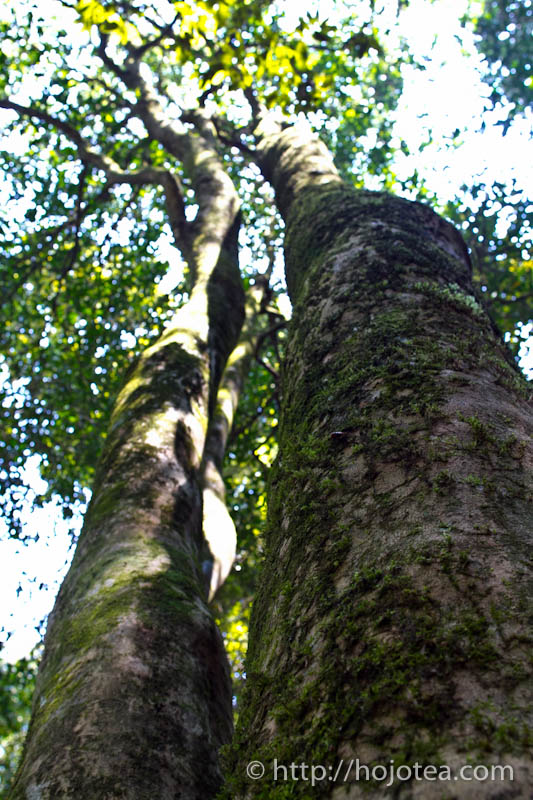 |
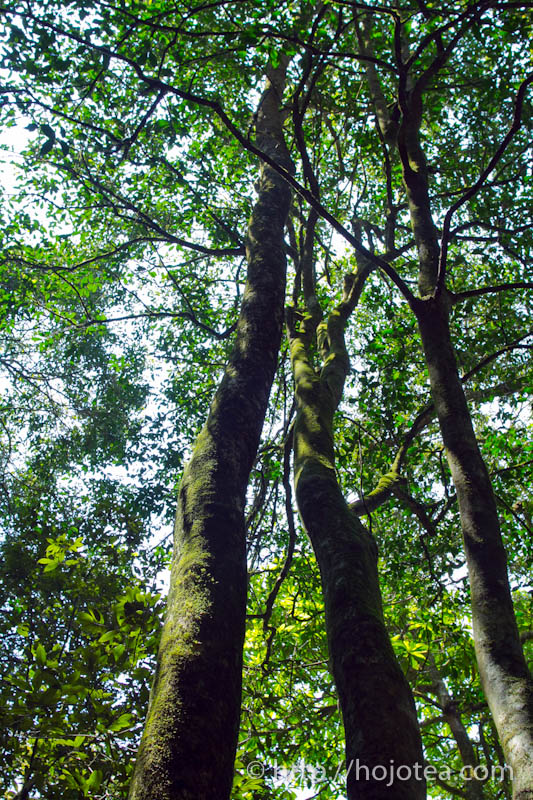 |
If we want to get tea with strong Hou Yun, we have to get it from the minority races. In China, the majority that dominates the economy and politics is Han Chinese. They are diligent and competent in business. On the other hand, the minority races consist of ethnic tribes from Thailand, Laos, Myanmar and Vietnam. Their nature is almost like South East Native Asian; generally they live a more relaxing lifestyle. Relatively Han Chinese dominates most of the historically famous manufacturing area of Pu-erh, while the minority Chinese dominates rural and mountainous area. As Han Chinese is known to be very aggressive in business, they are making a lot of efforts in producing better output from the limited tea mountain. They apply fertilizers and pesticides in order to produce more tea leaves from a single tree. Those efforts contribute in output, yet do not contribute to the quality of tea. Due to faster growing speed of the trees, the taste of tea becomes less thick and not to mention weaker in Hou Yun.
Among the Pu-erh tea collectors, there are 6 mountains located at the border town of Xishuang Banna which are very popular. These mountains became popular and well-known because they are located at the origin point of “The ancient tea and horse road”. However these areas are completely dominated by Han Chinese. Although these 6 mountains have reputations that are widely acclaimed, yet the quality of Pu-erh produced from these places are not very good nowadays.
In those famous tea areas, it is a very common practice that farmers often chop off the middle part of tea trees. Once tea tree is chopped, it starts to produce young shoots that will soon grow upwards. It grows faster and eventually produces more leaves as compared to the old trees, which are kept unattended. Unfortunately those trimmed or chopped tea trees cannot produce tea with good Hou Yun. The minerals and various substances are consumed for growing the young shoots. Usually the slower the tea tree grows, the better the taste and flavor the tea leaves produce. Although the bottom part of tree including its root is maintained as old tree, the quality of tealeaf produced has much lesser Hou Yun compared to young tree.
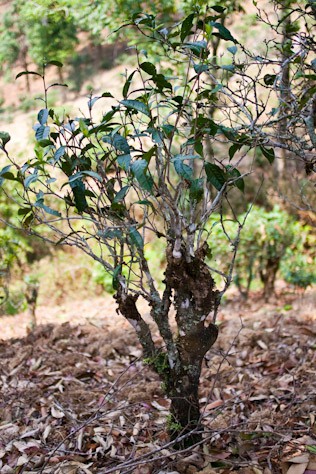 |
 |
|
Old tea tree that its middle part was chopped off. This kind of tea tree is very common in villages dominated by Han Chinese, e.g.. in Yiwu area which is very famous because of the mountain, yet the quality of tea is not very outstanding due to the attempt to increase the output. |
Old tree that its middle part was chopped off. |
On the contrary, the place where is dominated by minority races is nothing but natural. Relatively those minority people in Yunnan lives on half self-sufficient simple lifestyle and do not need to work too hard. It is not their culture to invest for fertilizer or pesticide. The tree is treated just like any other native plant in the mountain. All tea trees are not taken care and kept as it is. In addition, they do not pluck all over the year, but they pluck only a few times a year whenever they need some money. As a result, those tea plucked by minority races are relatively good quality.
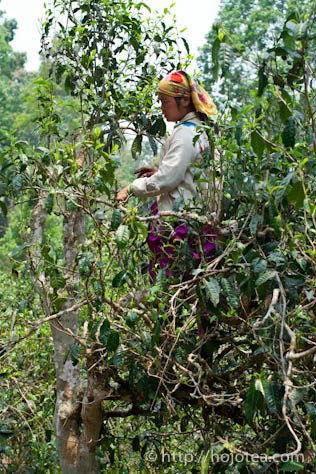 |
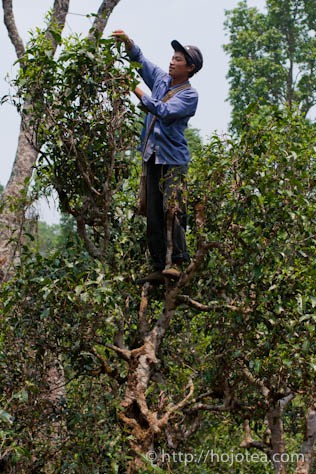 |
|
| A farmer from minority races is plucking the tea | Tea plucking is a very dangerous work indeed. |
|
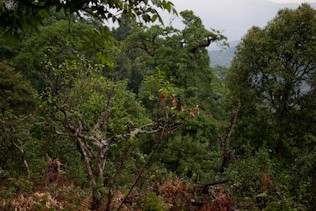 |
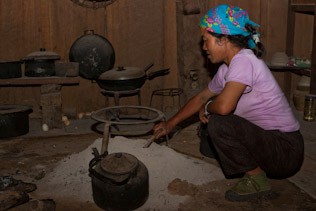 |
|
The area dominated by minority races is kept as native as forest. Tea tree is completely blended in other trees |
Inside the house of minority races. Likely the old style in Japan, fire is made inside house. |
The earliest plucked tea in the season always gives better quality, while the 2nd or 3rd plucked tea cannot be as good as the 1st plucked tea.
There is another secret that affects the quality of tea with regard to tea plucking. If a tea tree has been plucked too many times in this year, it will not produce good quality tea leaves in the next coming year. If tea leaves are plucked only once in spring, there is sufficient time for new grown tea leaf to accumulate minerals spending the rest of year. As a result, the Hou Yun of tea which is plucked in following year will be very strong. On the contrary, if a tea tree is plucked too often in a year, its tea leaves contain less mineral. If tea plucking is continuously carried out throughout early spring, late spring, summer, early autumn and late autumn, the tea tree has to work very hard in order to produce new batch of leaves. Eventually the tea tree is overworked and fewer minerals remain inside.
This problem becomes noticeable especially when the tea becomes popular in the market. Back in 2006-2007, the Pu-erh tea has reached its peak. The market demand of Pu-erh was dramatically increased. No sooner had the farmer produced Pu-erh than it was sold at once. In previous days, tea had been plucked twice a year on an average. However during 2006 to 2007, tea leaves were plucked throughout the whole year. As a result, the tea that was produced in 2008 has less Hou Yun.
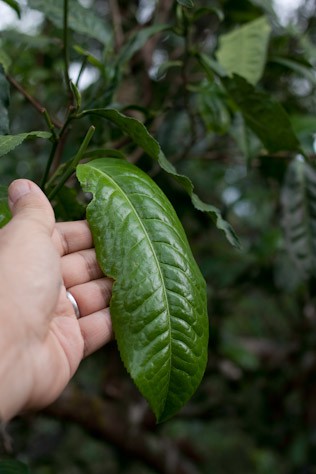 |
 |
|
| The twig of tea consists of 1 bud and 2-4 leaves | The market demand of puerh determines the frequency of plucking. If tea is plucked very often in this year, the quality of tea in next year will be inferior. |
The red soil is suitable for tea. It is basically the same as “red clay” that is rich in iron oxide. Although Yunnan is rich in red soil, certain places have soil that is particularly rich in iron. Wu Liang Shan and Lao Ban Zhang are well-known for their red soil. Tea produced in those areas is relatively good quality.
In addition to the red soil factor, there is one more important factor. In the mountain, the fallen leaves from the native trees accumulate on the ground. These dry leave also carry a lot of minerals. As time goes by, the fallen leaves will be decomposed by microorganism. When rain falls, the remains of decomposed leaves soaked by rain water and will eventually blend into the soil. Tea tree will intake extra minerals and at faster speed. Because of this reason, mountain tea always gives better Hou Yun compared to garden tea, unless the garden tea is planted at extremely high altitude.
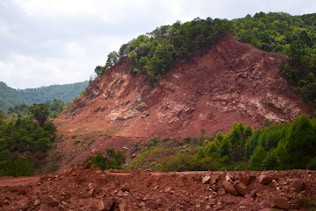 |
 |
|
| The typical appearance of soil at Wu Liang Shan | The mountain that produce quality Pu-erh is rich in red soil. Those soil are also exported as a red or purple clay. |
Just like wine, the quality of tea varies a lot depending on the year of production. For green tea and green oolong tea, we have to drink it within a year since we cannot preserve the tea. As for Pu-erh, we can store it as long as we wish. Hence it is meaningful to know which year is the “quality year” so that you can purchase and stock up a little more tea that is produced in a good year.
Basically the slower the growing speed, the better the quality it becomes. In other word, if a tea tree grows slower, its tea leaves have a better chance to accumulate minerals and organic substances than to consume it for growing purpose. Tea tree grows at night, while flavor and taste is produced in daytime. Tea can keep producing flavor and taste as long as sufficient sunshine is given in daytime regardless of it is growing or not. Growing means consuming. Quality of tea becomes better if the tree grows at slower speed. The same theory is applied to the fruits. The taste of fruit plucked in a rainy day is very thin and less sweet. It is not because sweetness is washed away. It is because the tree consumed its sweetness from the fruit since tree grows faster during rainy days.
In general, the dry and sunny weather is ideal for producing good quality tea. Tea tree absorb a lot of sunshine and conduct photosynthesis. In dry weather, the temperature at night tends to be very low due to radioactive cooling phenomenon. In addition, the semi-draught weather also provides less rain. As a result, tea tree grows slower.
If there is more rain in the spring, the quality of tea will not be good. Tea tree grows faster when sufficient water is provided. With faster growing speed, the taste of tea gets thinner and less Hou Yun.
Yunnan is one of the provinces in China. But its area is even bigger than Japan. The weather in Yunnan is not uniform and varied in different areas. The Southern part of Yunnan is much influenced by the weather of South East Asia, while South West and West Yunnan is affected by continental weather. Because of this reason, we cannot conclude which year is the best for all Yunnan teas. The quality year for each manufacturing area is different. For example, Xishuang Banna was hit by serious drought in 2010. The total output of tea produced in this year is reduced to 1/3 of production in a normal year. Subsequently, the lower output brings up the overall quality of tea although the price of tea increased.
Pu-erh is mass-produced in the factories and also in small scale by individual farmer using traditional method. Farmers processed tea from their own gardens at the mountain. Their quality is precisely representing the tea grown in their mountain and seldom they carried out blending with tea from other areas. If we want to look for quality tea in Yunnan, we need to control the origin of tea tree. Only the farmers can supply Pu-erh tea from a homogeneous origin. In particular, to obtain tea made from very old trees, it is necessary to obtain teas produced from farmers.
On the other hand, factories have big plants and many employees. Their objective is to sell tea by large quantity in order to pay for high fixed cost. Some factories also occupy tea gardens in the mountain that may have old trees or situated at higher altitude. However, they do not classify and segregate the quality of raw material according to the precise origin of the tree or the mountain, but to mix all the materials collected from all over the places, in order to even out the quality. Factories are concerned about sustaining a consistent quality of tea that they produced. Their mission is to sell in quantity in order to survive. Under the circumstances, the quality of Pu-erh tea produced by big factories tends to be averaged out. It is indeed possible to get upper-intermediate quality from the factory. But it is very difficult to get high-end quality from the factories.
For the ripe Pu-erh, it is not only the raw material that defines the intensity of Hou Yun, but also the fermentation caused by the mold. Mold by nature releases organic acid during fermentation (the secondary metabolites). The change of pH affects the concentration of mineral ion in tea. Only for ripe tea and some dark teas that are manufactured with microbiological fermentation, the intensity of Hou Yun differs before and after the fermentation. As for the black tea, oolong tea and raw Pu-erh tea, the intensity of Hou Yun remains exactly the same before and after the fermentation. It is because that the fermentation of those teas does not involve microorganism and therefore the pH of tea remains the same before and after the fermentation.
In this regards, the intensity of Hou Yun remains exactly the same no matter how long a raw Pu-erh tea is kept. The aging period only changes its flavor and mouth feeling.
Based on our experience, some customers have skeptical image about Pu-erh. Usually they do not like Pu-erh because of the moldy flavor. Obviously it was the trauma caused by the poor quality tea. The Pu-erh that gives moldy flavor is not only unpleasant for drinking, but also risky for health. Incorrect fermentation might have been conducted with wrong condition and therefore incorrect type of mold was cultivated. To be honest, there is a risk that tea might be contaminated by mold toxin (mycotoxin).
Some ripe Pu-erh tea gives flavor like dried squid or like smelly feet. That smell is caused due to the pollution with bacteria. The pollution is caused due to the incorrect method of fermentation.
Any smell that we don’t appreciate is what our body does not require. For health reason, it is not advisable to drink moldy or foul smelling Pu-erh. The good quality ripe Pu-erh gives similar flavor as dried Chinese dates or other dried fruit flavor. The variety of flavor is mostly depends on the technique of fermentation.
In Yunnan, no one uses drying machine for Pu-erh tea. If a drying machine is used, the enzyme that survived from earlier pan-frying process will be completely inactivated. Eventually it does not make a Pu-erh tea, but a green tea. Due to this reason, sunshine drying process is definitely carried out regardless of how big the scale of a factory. Both farmers and factories conduct sunshine drying for making Pu-erh. In big factories, they have huge yards allocated for sunshine drying and all processes including sunshine drying is carried out under proper management and supervision.
On the other hand, the tea made by the individual farmer is processed on household basis. Farmers who own small facility will first conduct the pan-frying, and later carry out sunshine drying right in front of their houses. As they use wood fire for cooking and pan-frying of tea leaf, tea sometimes absorbs the smoke. That is how tea gets the smoky flavor. We need to balance between the quality and the intensity of smoky flavor. If the extent of smoky flavor is marginal, it will usually disappear in 1-3 years.
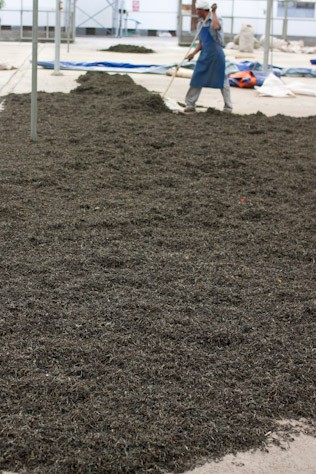 |
 |
|
| Production by Factory:
Tea is processed under strict management and supervision with the dedicated facilities. Hence it gives no smoky aroma. However tea leaves are all mixed regardless of altitudes, age of trees or timing of harvest. As a result, the quality is not more than average. |
Production by Farmer: Individual farmer carries out entire process in making Pu-erh. As they burn fire at a very close distance, tea leaf sometimes gets smoky aroma. After all, the smoky aroma will spontaneously disappear as time goes by. |
Storing Raw Pu-erh tea is one of the ways to enjoy it. The fermentation will slowly take place during storage. Initially the color of raw Pu-erh tea leaf is yellowish green. It gradually changes from yellow to amber, later into brown and dark brown at last. In addition to the changes of color, the flavor changes a lot. In fact the fermentation of raw Pu-erh is similar to haystacks that also generate sweet aroma after being kept for a few years.
On the other hand, if I would take an example to explain ripe Pu-erh, I will use the process of “compost” to describe the process. Both compost and ripe Pu-erh is made by the fermentation of mold. The character of ripe Pu-erh tea is not only depending on the raw material, but also the technique of mold fermentation used. We do not have to be so particular about the length of storage. A well-made ripe Pu-erh tea gives a very pleasant character even if it is merely one year old.
There are tea collectors who always look for vintage Pu-erh made by famous factory. Some Pu-erh cost even more than USD1000 per piece. Many customers wonder how good the vintage Pu-erh would be in taste and flavor, since it is so “expensive”.
Technically, the quality of tea in terms of Hou Yun never changes even if tea is kept for 20 over years. The intensity of Hou Yun remains exactly the same as the freshly produced tea throughout the years of storage. It is because intensity of Hou Yun has something to do with the minerals. Long storage does not affect the minerals, but organic substances.
Although aging of tea does not improve the Hou Yun, the aging creates variety of flavor and makes taste mellower on tongue. In general, Pu-erh raw tea kept for 1-3 years old tea gives flowery flavor. The 3-5 years old tea gives a fruity flavor and further storage will change its flavor towards dry-fruity flavor. As a conclusion, the aging of Pu-erh is to entertain the individual preference. Based on our experience, young people and ladies generally prefer less aged pu-erh, while elder people prefer more aged pu-erh.
Once upon a time, the production of tea from respective factory was extremely small. If one has ever visited Yiwu town, we can find the name of famous tea brand that still exists out there “as a sign of each house”. In the old days, so-called tea factory was just like individual farmer and they produced Pu-erh tea in a small scale. For now, those factories are no longer making good quality tea as before. They do not have a choice since the mission of the factory is to maintain high output.
In the past, especially after 1949, communist government prohibited private business ownership. This is why the old housing brand owned by individual was stopped and only big factories owned by government were allowed to produce Pu-erh. From 1949 to 1990, several big factories dominated the pu-erh tea production, for example the four most well-known factories were Kun-ming Tea Factory (昆明茶厂) , Meng-hai Tea Factory (勐海茶厂) ,Xia-guan Tea Factory (下关茶厂) ,and Lin-chang Tea Factory (临沧茶厂).
During this period, those state-owned big factories had sometimes produced very good quality batch thanks to many skilled technicians, and well control of raw materials. But later on since 1990's, those state-owned factories were all privatized and divided into several small factories. The most important influence is that the old technicians retired, and the factory lost its autonomy control on the tea garden in the mountain. Now it's very difficult to obtain prestigious quality tea from the factory. Eventually tea collectors always search for those old batches of tea produced in a period that quality was well managed.
About 20-30 years ago, the skilled technician who worked for state-owned factory carefully selected and segregated the tea trees, from the mountain and the altitudes. Some batches of Pu-erh could have been of very good quality. I came across with a customer who was fortunate to have tasted those legendary good Pu-erh teas and deeply believe that it was because of the “age” that makes the quality very good. As I explained earlier, it is not because of the “age”, but raw material that was carefully managed at that time.
For now, the organization of tea factories is different and they no longer produce good quality Pu-erh like the old days. Under the circumstances, the Pu-erh tea they produced today will not become better even if it is kept for another 20-30 years.
For now, if we want to buy equally good quality Pu-erh as those vintage Pu-erh, we ought to look for the tea produced by individual minority farmers. The minorities still produces excellent quality till now using old traditional methods.
The fermentation of raw Pu-erh requires a lot of skills, cares and attentions. If the tea is simply kept in humid conditions, tea leaves will deteriorate rapidly. Excessive moisture in the atmosphere triggers unwanted oxidation and the growth of microorganism. The tea subsequently produces moldy or earthy flavor. Ironically, a lot of Pu-erh collectors misunderstand that moldy and earthy flavor is what a vintage Pu-erh is supposed to taste like.
It is said that a Pu-erh tea should be fermented in the original paper wrapping and stored in open space. However this method is not practical in most of our living environment. This traditional storage method only works in Yunnan or any place where it is located at an equivalently high altitude, as the weather in Yunnan is very dry with low humidity.
From the food scientific point of view, any kinds of tea must be kept in low humidity. In fact, we highly recommend keeping Pu-erh tea in a tightly sealed aluminum bag. The oxygen trapped inside the bag is sufficient enough to mediate further maturation. Pu-erh tea kept inside a sealed aluminum bag can be very well matured compared to those that are kept in open space. There is another way to create a unique maturation method for Pu-erh. We suggest keeping raw Pu-erh in a vacuum-sealed bag. Most people may think this storage method is ridiculous. Traditionally, Pu-erh tea is compressed to remove oxygen from the leaves and kept it intact. It was the wisdom of ancient people to keep tea without oxygen and let it matured very well.
From scientific point of view, oxidation does not only refer to receiving oxygen. The oxidation also takes place when it releases hydrogen and receives electron. Even if tea is kept without oxygen, it will still undergo oxidation.
In 1960's, generally Pu-erh tea was compressed tightly and shaped like a bing (flat and thin round cake). It was called “iron bing”. The tea leaf was compressed extremely tight until it became like a piece of stone; we can hardly pry it even if we use the proper tool that designed for prying the Pu-erh cake. This style of compression succeeded the elimination of oxygen from the tea leaves. If you have ever tried this kind of Pu-erh iron bing, you would know that it was very well-matured. It gives flavour like honey with fruity note and gives no earthy flavour at all. The only problem is that it is so difficult to loosen the leaves from the iron bing and the leaves are often damaged during the process.
On the other hand, nowadays most of Pu-erh cakes are loosely compressed. Some of the Pu-erh cakes can be easily break apart by fingers. Obviously there is oxygen remained in between the leaves. If we keep loosely-compressed Pu-erh in ambient environment, tea will expose to not only oxygen but also moisture and develop unwanted oxidation that usually generates earthy flavour. To achieve the same maturation effect like the iron bing, we encourage customer to keep Pu-erh tea without oxygen. With modern technology, we are able to apply the same theory. Some people in Taiwan intentionally keep high mountain oolong in the vacuum bag for a few years. In the beginning, high mountain oolong is green in colour and it gives a delightful fresh flowery flavour. After a few years of maturation, the leaves turn into yellow colour and it gives the flavour like ripen peach or apricot. This is exactly the same effect as what we are looking for in Pu-erh tea. Based on our experience, well-matured Pu-erh tea gives a very fruity flavour and no earthy or mouldy flavour at all.
In fact, the best environment to keep Pu-erh tea is still in Yunnan by itself. For any food that requires a long term aging process, the dry and less hot weather condition is the best. Tropical weather on the contrary is the worse kind of weather for aging of the tea. It will promote nothing but excessive oxidation and microbiological contamination. The tea businessmen in Yunnan know this very well.
As a matter of fact, the boom of Pu-erh tea was already over in 2007. In 2008, the market shrunk and demand decreased drastically. There were a lot of Pu-erh tea companies in Yunnan that went bankrupt in 2008 as well. Until today, Pu-erh tea companies in Yunnan, especially factories are suffering from a number of outstanding stocks that was carried over from previous year. In 2010, many tea marketing companies situated in Kunming (the capital of Yunnan) stopped purchasing raw materials from manufacturers as they already carry more than sufficient amount of stock to sell in this year. From the logical point of view, they are absolutely not interested in buying back Pu-erh from SE Asia. Nevertheless it takes a while time for the enthusiastic “Pu-erh investors” to wake up from their dream. In the future, the Pu-erh market will gradually adjust back to normal as before 2006. It is rather good for consumers since we can now easily obtain better quality Pu-erh with a more reasonable price.
The most common shape of Pu-erh tea is in round and flat shape that looks like a piece of pizza. But the original shape of Pu-erh tea is loose-leaf form that is just like green tea. If we are to select tea at manufacturing area in Yunnan, the tea prepared for tasting is mostly in loose-leaf form. It is the trader who purchase loose-leaf and compress it into whatever shape that we desire. Based on the original loose-leaf form, it is easier for buyer to judge the quality and also to make sure the tea is not blended leaves. Loose tea is subsequently steamed and compressed into the intended shape and size. The reason to compress tea leaf is for logistics convenience. Compressed form is less bulky and therefore much easier to carry for long distance traveling. The shape of tea leaf does not have anything to do with the quality, unless manufacturer made a mistake while drying.
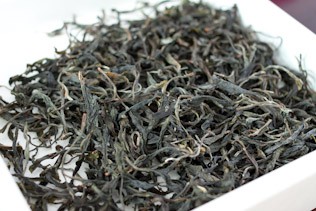 |
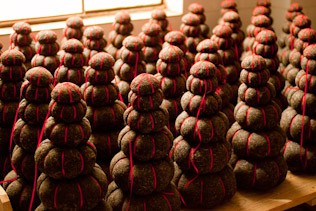 |
|
The original shape of Pu-erh tea. This will be compressed into various shapes in order to minimize the space occupied during transportation or for storage. |
Pu-erh tea can be compressed into any shape as long as a mold is ready. |
Tea is compressed into various shapes according to the requirement of clients or sometimes the intension of the manufacturer to do so. Recently, tea shaped in a very small ball-shape called mini tuo cha is getting popular among tea drinkers. It is as small in size like a chestnut and usually it is in about 5-7g in average. Some people think that mini tuo cha is of lower quality or lower production standard. It was because some factories used to produce mini tuo cha from broken tea leaf. In any case, the shape of tea has nothing to do with the quality including mini tuo cha. Usually we purchase loose tea and instruct the manufacturer to produce the shape we want. In fact, mini tuo cha shape is very handy. As it is just nice for one brewing and easy to be carried around in our pocket, it is also a suitable size for brewing and drinking at working place.
Following photo shows how pu-erh tea is compressed into pizza shape. Basically tea is soften with hot steam, packed in cotton bag and compress it immediately. The entire process is taken place within 1min. The following photo was taken in the big factory. But the process itself is more or less the same regardless of the scale of production.
 |
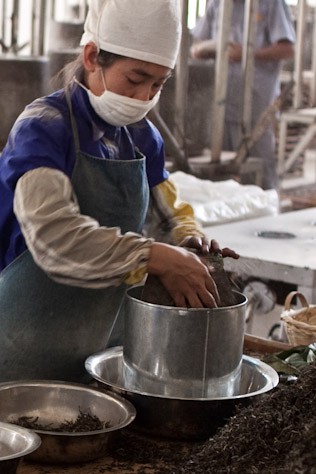 |
|
1. Weighing tea leaves |
2. Placing tea leaves into the metal mold |
|
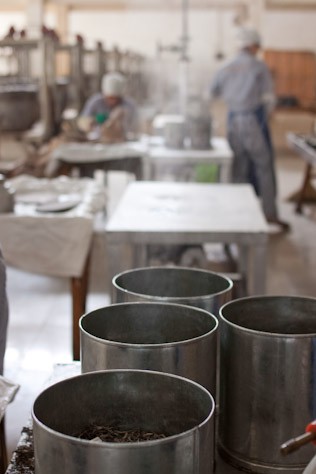 |
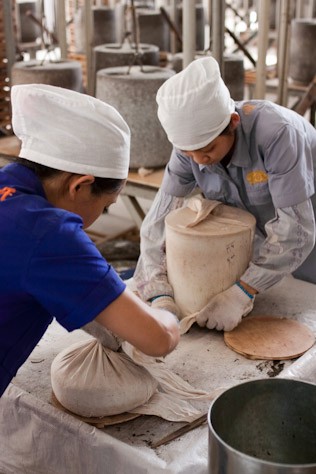 |
|
| 3. Steam is applied from the bottom of mold. The steaming process only takes a few seconds | 4. soften leaf is then repacked into a cotton bag, squeezed and then made into the shape like a piece of pizza. |
|
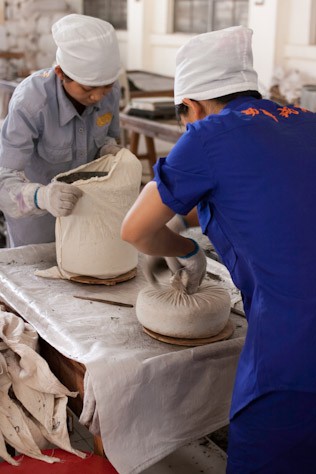 |
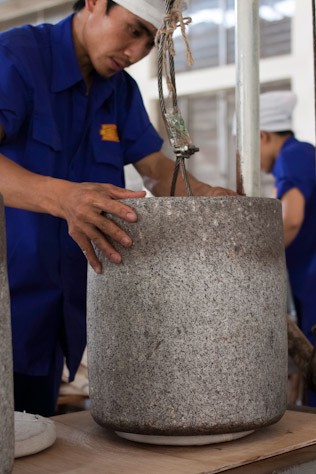 |
|
5.The handling must follow a very smooth motion in order to maintain the consistency in shape. A skilled tea maker takes less than 10 seconds to complete it. |
6.A stone is used to compress the tea leaves. |
|
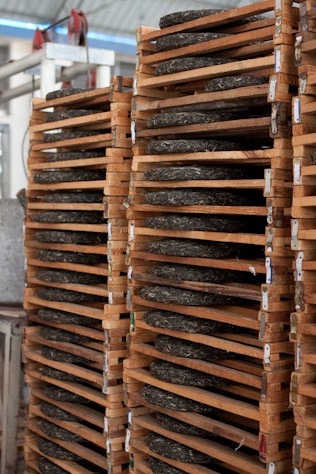 |
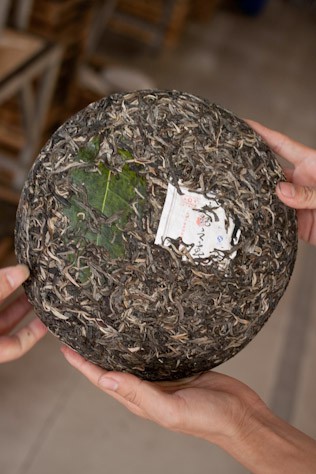 |
|
7.Compressed tea is kept in the shelf and dried. If drying is not effectively carried out, tea will be damaged due to remaining moisture inside the tea leaves. |
8.This is a raw Pu-erh tea. Tea can be processed into any shape as long as mold is available. |
The joy of drinking Pu-erh tea is that we can enjoy and discover different varieties of tea from various ages of tea tree.
Realistically only in Yunnan tea that we can enjoy tea produced from very old trees. The taste, flavor and not to mention Hou Yun is precisely reflected from Pu-erh’s long history, its growing environment and the people who produce this tea. In a way, Pu-erh tea is representing the history, culture, weather and land of Yunnan.
Another interesting thing about drinking Pu-erh is enjoying its variation of flavor through aging. The flavor of Pu-erh varies as much as we change as time goes by. Customizing the flavor according to your own preference, you will be a part of manufacturing it. It is fun to serve different flavors of Pu-erh at different occasions and for different guests.
Our Pu-erh is made with no blending or mixing but from a single origin. Please try and understand what we are trying to explain.